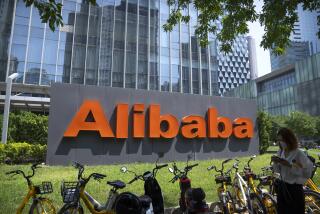How Alibaba found riches
SHANGHAI — Five years ago, with just $13,435, Chen Qiutian launched a business making motorized golf-bag trolleys, golf carts and scooters for the disabled. But his little workshop was in the small, out-of-the-way city of Jinhua, 175 miles southwest of Shanghai.
So in 2003, Chen started selling his goods through Alibaba .com, an Internet intermediary for China’s 30 million small and medium-size manufacturers. The first year he was on the site, revenue increased tenfold, from $671,800 to $6.7 million.
This year he expects Jinhua Ripu Electric Scooters Co.’s sales to reach $13.4 million -- and 90% of his business comes from e-commerce.
“You can bargain on the Internet, confirm the number, type, everything directly,” Chen said. “I have made deals with [buyers], some over several years . . . but we never met.”
Alibaba.com Ltd. shares started trading on the Hong Kong exchange Tuesday and tripled on the first day, marking a new chapter in China’s technology story: the arrival of e-commerce.
The offering catapulted the Hangzhou-based firm to the top tier of Asian Internet companies -- even after investor profit-taking Wednesday dropped its market valuation to $22.1 billion from more than $25 billion the day before. Some analysts say the stock’s lofty valuation -- it is trading at 320 times the company’s projected 2007 earnings -- is more a bet on Alibaba.com’s future than on market fundamentals.
Alibaba.com was founded in June 1999 by Jack Ma, who saw an opportunity to play matchmaker for small and medium-size Chinese manufacturers, which lacked access to global markets for products as varied as bamboo toothpicks, bath towels and machine tools. Likewise, international buyers interested in goods from manufacturers in China lacked the communications channels to find them.
Ma established two websites to address those markets: one in English to facilitate international trades (alibaba.com) and one in simplified Chinese for domestic business (china.alibaba.com), from which the company derives more than 70% of its revenue.
“This idea of creating a global platform to tie in European and U.S. buyers into all these small and medium-sized manufacturers, it made a lot of sense,” said T.R. Harrington, co-founder and chief executive of Darwin Marketing, a Shanghai-based company specializing in search and affiliate marketing. “Previously, it had been done by global sources [through] magazines.”
Two factors helped spur the growth of Alibaba.com -- one logistical, one technical.
As China becomes more prosperous, an increasing number of households and businesses have access to the Internet and high-speed connections. The number of Internet users reached 137 million in 2006, up from 59.1 million four years earlier. That gives online services like Alibaba.com reach.
Meanwhile, companies including FedEx Corp., United Parcel Service Inc. and Deutsche Post subsidiary DHL International started to offer services in China, improving the odds of timely delivery.
The number of companies that use the Internet for business-to-business transactions has grown in tandem -- an average of 72% annually since 2002, according to IResearch, a technology analysis group based in China.
Alibaba is exhibiting the kind of growth trajectory -- a projected 82% annually from 2004 through this year -- that analysts last saw with Google Inc.
“We expect this growth to remain strong for at least the next decade, when we expect the majority of businesses using these services will be paying,” Jeffrey Lindsay, a senior analyst with Bernstein Research, wrote in an extensive, three-part analysis of Alibaba.com.
Lindsay said Alibaba.com recognized early on that some of the fledgling companies would have difficulty paying for access to electronic markets, so it initially offered services free to establish the market, grab market share and position itself for the day when it could charge a fee for the services.
Suppliers can pay an annual fee to become so-called premium members, which gives them preferential access to buyers.
Currently, only about 4% of the 8.8 million manufacturers that use the online marketplaces actually pay for the service, according to Bernstein’s estimates.
But as more business is conducted online -- IResearch estimates that as many as 41 million small and mid-size manufacturers will turn to Internet markets by 2012 -- Alibaba is positioned to grab it. It already commands 69% of the revenue, and its market share has been increasing over the last four years.
“Alibaba.com will increasingly become the must-use channel for the majority of sellers,” Lindsay said.
“This is the classic network effect of Internet businesses, and it works in favor of the player that gets biggest first -- in this case, the first player is Alibaba.com.”
Alibaba Group has expanded into other areas.
In 2003, Ma started Taobao, a consumer auction site with instant messaging. That lets buyers and sellers get to know one another through messages, voice mail and posts before transacting business. It had amassed 40 million registered users by the end of the second quarter, and it has driven U.S. rival EBay Inc. out of China.
Knowing that most Chinese don’t have credit cards to make online payments, Ma introduced AliPay, a system that keeps cash in escrow until the goods arrive. It had 33 million registered users by the end of 2006 and achieved a daily transaction volume of $12.8 million, according to American Technology Research.
Yahoo Inc., based in Sunnyvale, Calif., acquired a 39% stake in Alibaba Group in 2005, paying $1 billion together with its foundering Yahoo China operations.
More to Read
Inside the business of entertainment
The Wide Shot brings you news, analysis and insights on everything from streaming wars to production — and what it all means for the future.
You may occasionally receive promotional content from the Los Angeles Times.










